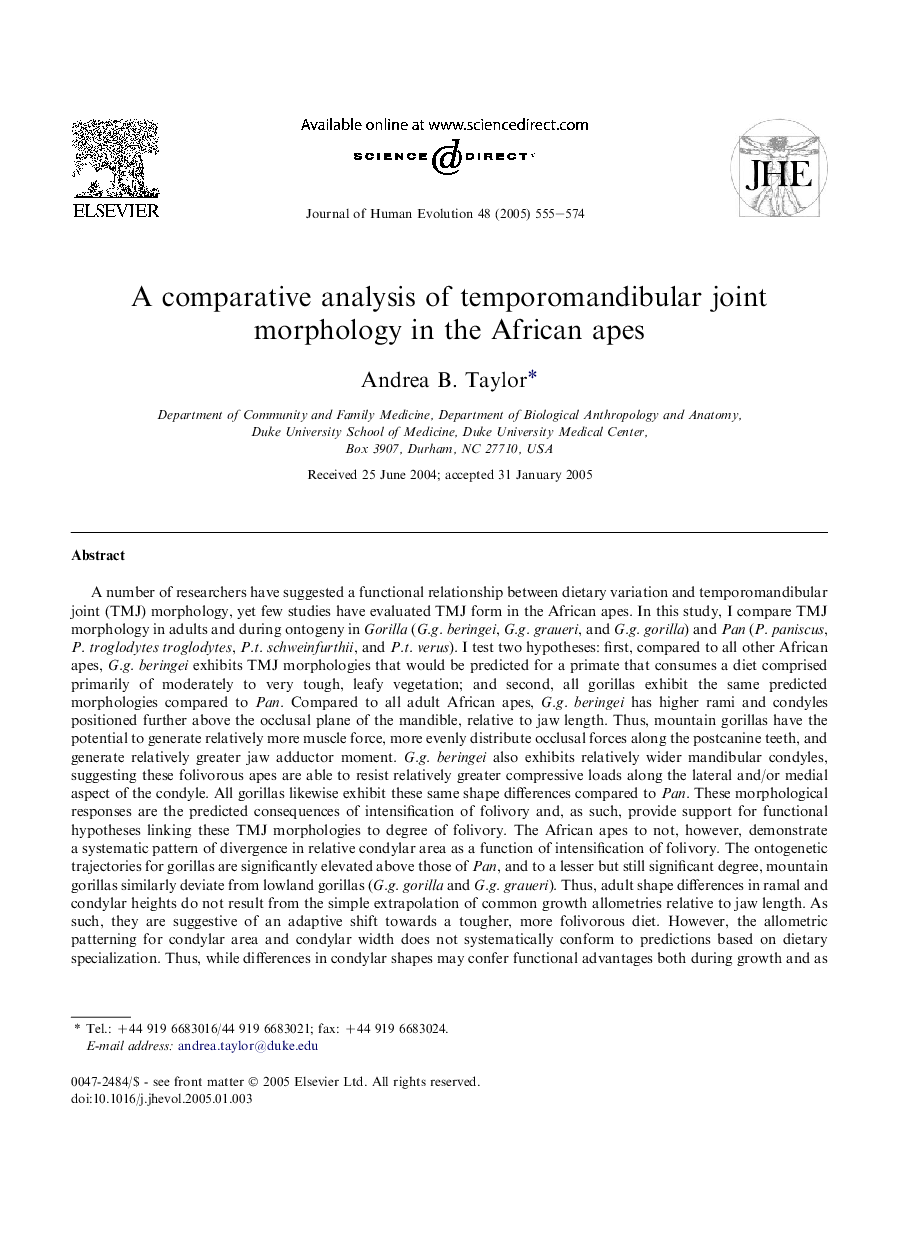| کد مقاله | کد نشریه | سال انتشار | مقاله انگلیسی | نسخه تمام متن |
|---|---|---|---|---|
| 9486096 | 1329577 | 2005 | 20 صفحه PDF | دانلود رایگان |
عنوان انگلیسی مقاله ISI
A comparative analysis of temporomandibular joint morphology in the African apes
دانلود مقاله + سفارش ترجمه
دانلود مقاله ISI انگلیسی
رایگان برای ایرانیان
کلمات کلیدی
موضوعات مرتبط
علوم زیستی و بیوفناوری
علوم کشاورزی و بیولوژیک
بوم شناسی، تکامل، رفتار و سامانه شناسی
پیش نمایش صفحه اول مقاله

چکیده انگلیسی
A number of researchers have suggested a functional relationship between dietary variation and temporomandibular joint (TMJ) morphology, yet few studies have evaluated TMJ form in the African apes. In this study, I compare TMJ morphology in adults and during ontogeny in Gorilla (G.g. beringei, G.g. graueri, and G.g. gorilla) and Pan (P. paniscus, P. troglodytes troglodytes, P.t. schweinfurthii, and P.t. verus). I test two hypotheses: first, compared to all other African apes, G.g. beringei exhibits TMJ morphologies that would be predicted for a primate that consumes a diet comprised primarily of moderately to very tough, leafy vegetation; and second, all gorillas exhibit the same predicted morphologies compared to Pan. Compared to all adult African apes, G.g. beringei has higher rami and condyles positioned further above the occlusal plane of the mandible, relative to jaw length. Thus, mountain gorillas have the potential to generate relatively more muscle force, more evenly distribute occlusal forces along the postcanine teeth, and generate relatively greater jaw adductor moment. G.g. beringei also exhibits relatively wider mandibular condyles, suggesting these folivorous apes are able to resist relatively greater compressive loads along the lateral and/or medial aspect of the condyle. All gorillas likewise exhibit these same shape differences compared to Pan. These morphological responses are the predicted consequences of intensification of folivory and, as such, provide support for functional hypotheses linking these TMJ morphologies to degree of folivory. The African apes to not, however, demonstrate a systematic pattern of divergence in relative condylar area as a function of intensification of folivory. The ontogenetic trajectories for gorillas are significantly elevated above those of Pan, and to a lesser but still significant degree, mountain gorillas similarly deviate from lowland gorillas (G.g. gorilla and G.g. graueri). Thus, adult shape differences in ramal and condylar heights do not result from the simple extrapolation of common growth allometries relative to jaw length. As such, they are suggestive of an adaptive shift towards a tougher, more folivorous diet. However, the allometric patterning for condylar area and condylar width does not systematically conform to predictions based on dietary specialization. Thus, while differences in condylar shapes may confer functional advantages both during growth and as adults, there is no evidence to suggest selection for altered condylar proportions, independent of the effects of changes in jaw size.
ناشر
Database: Elsevier - ScienceDirect (ساینس دایرکت)
Journal: Journal of Human Evolution - Volume 48, Issue 6, June 2005, Pages 555-574
Journal: Journal of Human Evolution - Volume 48, Issue 6, June 2005, Pages 555-574
نویسندگان
Andrea B. Taylor,